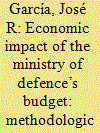| Srl | Item |
| 1 |
ID:
160214


|
|
|
|
|
| Summary/Abstract |
This article analyses the economic impact of the expenditure budget of the Spanish Ministry of Defence (MoD) and its Autonomous Agencies (AA), distinguishing direct, indirect and induced effects. The input–output methodology is used to find intersectoral effects on the rest of the economy. The article quantifies the economic impact in terms of production, gross value added (GVA), employed population, tax revenue, and also in terms of its contribution to the gross domestic product (GDP) of Spain in 2010. The results show that the activity of the MoD and AA generates 1.2% of the country’s GDP and 1.7% of total employment in that year.
|
|
|
|
|
|
|
|
|
|
|
|
|
|
|
|
| 2 |
ID:
148658


|
|
|
|
|
| Summary/Abstract |
Researchers seeking to establish causal relationships frequently control for variables on the purported causal pathway, checking whether the original treatment effect then disappears. Unfortunately, this common approach may lead to biased estimates. In this article, we show that the bias can be avoided by focusing on a quantity of interest called the controlled direct effect. Under certain conditions, the controlled direct effect enables researchers to rule out competing explanations—an important objective for political scientists. To estimate the controlled direct effect without bias, we describe an easy-to-implement estimation strategy from the biostatistics literature. We extend this approach by deriving a consistent variance estimator and demonstrating how to conduct a sensitivity analysis. Two examples—one on ethnic fractionalization’s effect on civil war and one on the impact of historical plough use on contemporary female political participation—illustrate the framework and methodology.
|
|
|
|
|
|
|
|
|
|
|
|
|
|
|
|